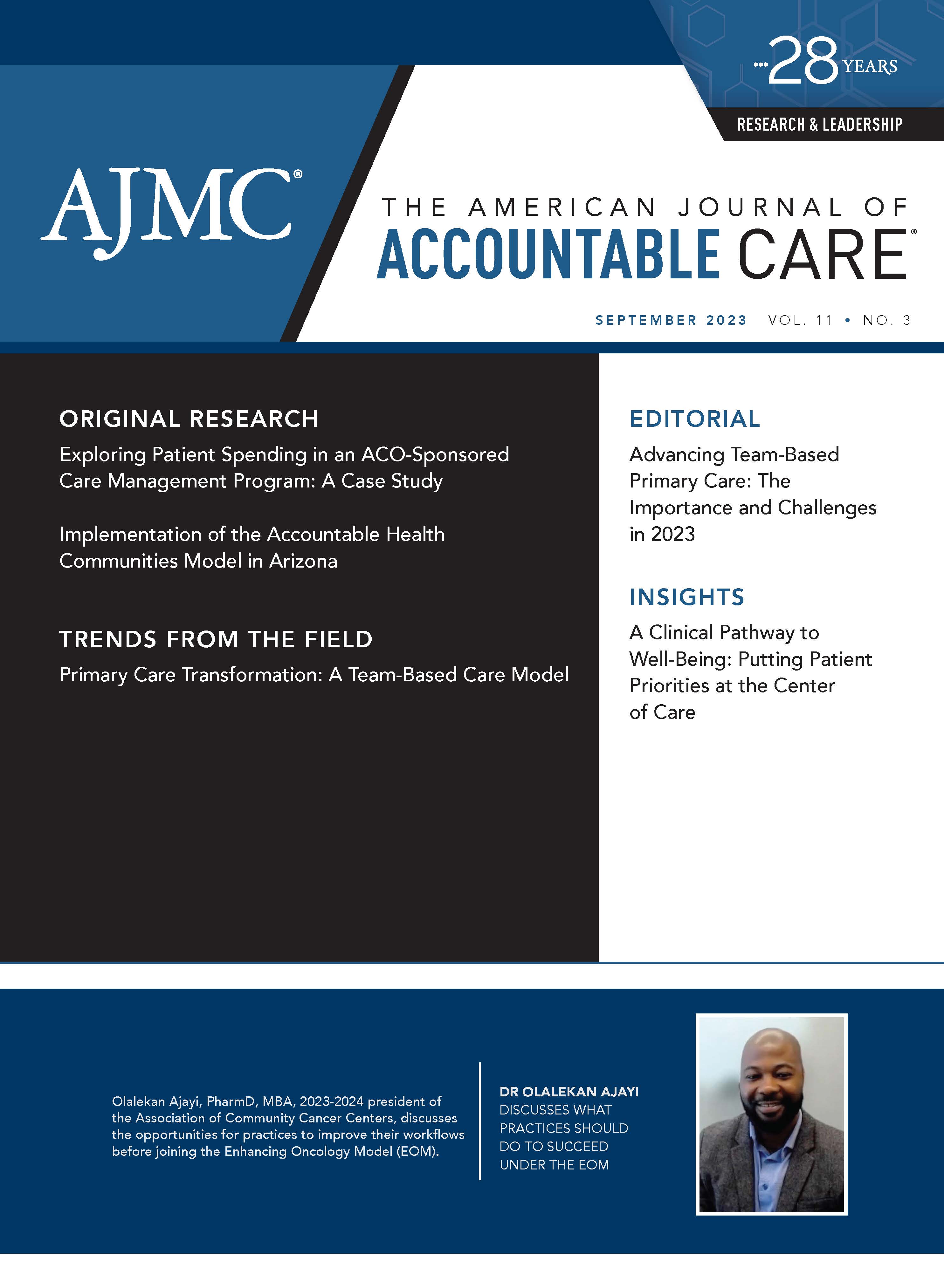Publication
Peer-Reviewed
Population Health, Equity & Outcomes
Primary Care Transformation: A Team-Based Care Model
Author(s):
This article presents a descriptive review of a team-based care transformation model in a large primary care network, including core staffing, process improvement, and extended care teams.
ABSTRACT
Allegheny Health Network implemented a team-based primary care transformation process across its large primary care network. Goals of the initiative included enhancing the quality and experience of care, improving population health, supporting clinician wellness, and preparing for the shift from volume- to value-based reimbursement models. Cohorts of 10 to 12 practices were sequentially introduced to the model and guided through the transformation process by a team of primary care clinical and operational leaders and a team of transformation specialists. The model included 3 components: (1) core care team staffing consisting of physicians, advanced practice providers, nurses, medical assistants, and health coaches; (2) process improvement including learning collaboratives and practice coaching from transformation specialists; and (3) the integration of behavioral health consultants, pharmacists, and registered dietitians into the care team. Key performance indicators were monitored throughout the transformation process and used to inform continuous process improvement.
The American Journal of Accountable Care. 2023;11(3):28-31. https://doi.org/10.37765/ajac.2023.89435
Allegheny Health Network (AHN) transformed its primary care delivery model to improve patient outcomes, practice efficiency, and clinician wellness. This aligns with AHN’s mission to “create a remarkable health care experience, freeing people to be their best”1 and reflects the reimbursement changes that prioritize value. Initiative goals included better care coordination, enhanced chronic disease management, and the integration of social determinants of health into the treatment plan to support effective whole-person care for each patient. The transformation initiative has been facilitated by clinical and operational leaders within AHN’s Primary Care Institute along with a team of 5 transformation specialists.
Given the volume of practices and wide geographical footprint of AHN’s western Pennsylvania market, transformation was implemented in waves with cohorts of 10 to 12 practices launching every 6 to 9 months. The implementation of the phases across nearly 100 primary care offices began in September 2017 and is expected to conclude in early 2024. As an individual practice joined a wave, it progressed through 3 stages of transformation, starting with optimizing staffing, transitioning to continuous process improvement, and culminating in integrating new clinical team members. The initial 6 to 8 months of transformation were the most intense and demanding for the medical team at a particular practice. Over time, they became more experienced, developed core competencies, and grew more comfortable with the habits of continued improvement. As a result, the level of support needed from the transformation team decreased. This freed up the transformation team to initiate the next wave with a new cohort of practices while still providing support, as needed, to practices further along in the transformation process. The assignment of a practice to a particular wave and the timing of the different waves were influenced by several factors, including a practice’s readiness for change, panel size, geographic location, and experience with the Epic electronic health record system.
Phase 1 optimized staffing by creating a core care team that was consistent for all practices. This contrasted with the old staffing models, which varied across practices and most commonly consisted of a 1:1 staffing ratio of primary care physicians to medical assistants (MAs). Phase 1 augmented the core team with advanced practice providers (APPs), health coaches, and registered nurses (RNs) who support clinical access, provide population health and care management, and standardize staffing ratios across the practices. The responsibilities and workflows of each team member were clearly defined for each practice to maximize efficiency. The responsibilities of the APPs varied by office and the practice population’s needs: Some carried their own patient panel, and others focused on assisting their collaborating physicians with expanding access by providing acute/same-day visits and patient follow-up. The RN was responsible for transitions of care, care management, and patient triage. The MA escorted patients to the exam room and completed important health screenings (eg, vitals, depression, social determinants of health). The health coach—an MA or a licensed practical nurse—concentrated on population health efforts, including previsit planning, facilitation of care team huddles, and proactive population outreach. The typical staffing ratio of the augmented core care team model was 2.5 full-time equivalents of clinical support to every 1.0 full-time equivalent physician managing a patient panel of 1800 to 2000 patients.
With a new core team in place, phase 2 was implemented to improve processes. Each practice designated 2 transformation champions—1 administrative team member and 1 clinician—to serve as leaders for the transformation. The champions from each office joined learning collaborative sessions with their fellow cohort peers every 3 to 4 weeks. The collaborative sessions were focused on team-based concepts, including quality improvement methodology, previsit planning, population health outreach, access, and care management. Each session included an overview of the concept of focus, why it was important, recommended workflows, and implementation strategies. Between learning collaborative sessions, the practice champions worked with transformation specialists, who were trained in process improvement and workflow redesign, to implement changes in their offices. Each subsequent learning collaborative session began with a discussion of the changes implemented since the previous session, barriers encountered, and successes achieved. Participating practices have reported that sharing of best practices has led to workflow improvement and greater cohesion between offices as they learn from each other’s strategies, successes, and challenges.
Phase 3 introduced extended care teams (ECTs) into practices. This was only done after a solid process improvement foundation was in place, typically 6 to 8 months after the launch of phase 1. ECTs were integrated into the practice using a defined ratio of patient panel size to each ECT member: clinical pharmacists (10,000:1), behavioral health consultants (BHCs; 6000:1), and registered dietitians (16,000:1). These ratios helped practices determine proper staffing levels and adjust workloads. The addition of these clinicians allowed for the expansion of the scope and comprehensiveness of the primary care delivered in these practices. ECTs support continuity of care and appropriate utilization—the right care in the right place at the right time—by holistically managing patients who may have traditionally been referred to specialists. Feedback from participating physicians has highlighted the perceived value of team-based care, as they report that they cannot imagine returning to how they practiced medicine before the addition of the ECT members.
At the onset of the initiative in 2017, AHN’s executive leadership team committed to funding the investment in additional core staff, ECT staff, and transformation specialists. Financial outlays were incurred incrementally for each wave. The return on investment was assessed through enhanced value-based reimbursement (VBR), fee-for-service reimbursement for BHC services, and improved transitional care management billing.
One key performance indicator (KPI) used to assess return on investment was the aggregate quality score for a Medicare Advantage population for one of our larger payers. The score is referred to as a Stars score, modeled after the 5-star rating system that CMS uses to rate health plans. The large payer in our region rates the AHN primary care network on its aggregate Stars score and factors it into the VBR for AHN’s Medicare Advantage–attributed population. The aggregate rating assesses performance on preventive and chronic care quality measures, such as cancer screenings, medication adherence, and diabetes management.
The aggregate score for AHN’s primary care practices has a significant impact on VBR from this payer. For example, in 2020 the aggregate Star rating for the practices involved in primary care redesign was 4.62 vs 4.44 for practices not yet involved in the initiative. The overall aggregate rating across all AHN practices, driven by the cohort of transformed practices, exceeded the 4.5 threshold needed to trigger a superior performance bonus, resulting in earnings of $983,000 in addition to the base VBR earnings achieved in the program. These additional, unbudgeted bonus earnings, on top of the budgeted VBR earnings for 2020, exceeded the annual investment made in staffing and transformation program support and produced a return on investment. Similar enhanced performance has been demonstrated across the portfolio of VBR programs in which AHN participates. The transformation initiative has laid a strong foundation for AHN to venture into advanced VBR models such as gain share, capitation, and full-risk arrangements, positioning us to succeed in the shift from fee-for-service to value-based payment.
Throughout the implementation, KPIs of involved practices were monitored for changes relative to baseline performance. KPIs included quality scores, care gap closure rates for diabetes-related metrics, depression screening rates, transitional care management rates, and total cost of care for patients engaged with a BHC relative to a matched cohort who did not engage. Performance on KPIs was routinely reviewed with participating practices and used to guide quality improvement activities as well as to keep executive leaders informed on the initiative’s progress. For 2 practice cohorts (waves 1 and 2), depression screening rates improved over time, relative to preimplementation, compared with nontransformed practices (Figure 1). Another example of KPI monitoring is evaluating the completion rate of calls made to patients 2 days after discharge from the hospital. There was a clear increase in completion rates after the wave 3 cohort of practices initiated transformation (Figure 2). Associations have been observed between involvement in the initiative and longitudinal improvement of multiple KPIs. It should be noted that there are limitations to drawing causal relationships between the improvement trends and involvement in the initiative because other factors may have affected the outcomes. Even so, we believe the trends reflect an increased value of care.
At present, 7 waves have been initiated, and all AHN primary care practices are engaged in the team-based care model. Although the frequency and intensity of the practices’ engagement with the transformation team lessen over time, all practices remain engaged in the initiative through periodic learning collaborative sessions and coaching from the practice transformation specialists.
The transformation journey has been both challenging and rewarding. It required the commitment of leaders, clinicians, and care team members across the organization. The stamina to sustain engagement in the transformation journey was particularly challenged by the COVID-19 pandemic and its myriad impacts on care delivery, patient engagement, and office staffing and morale. Despite challenges, the sharing of best practices, collaboration with team members, and focus on process improvement have contributed to better health care and an improved experience, making the transformation well worth the effort. The process of transformation has helped us to focus on delivering upon the quintuple aim of health care—reducing costs, improving quality, optimizing patient experience, supporting clinician wellness, and ensuring health equity. Next steps include expanding the initiative to AHN pediatric and women’s health practices.
Acknowledgments
The authors thank Sarah Carey, MS; Jade Chang; and Jacalyn Newman, PhD, of Allegheny Health Network’s Health System Publication Support Office (HSPSO) for their assistance in editing and formatting the manuscript. The HSPSO is funded by Highmark Health (Pittsburgh, Pennsylvania), and all work was done in accordance with Good Publication Practice guidelines.
Author Affiliations: Allegheny Health Network (HD, KH, WJ), Pittsburgh, PA.
Source of Funding: None.
Author Disclosures: The authors report no relationship or financial interest with any entity that would pose a conflict of interest with the subject matter of this article.
Authorship Information: Concept and design (HD, KH, WJ); drafting of the manuscript (HD, KH, WJ); critical revision of the manuscript for important intellectual content (HD, KH); administrative, technical, or logistic support (HD, KH); and supervision (WJ).
Send Correspondence to: Heather Daugherty, BA, Allegheny Health Network, 120 Fifth Ave, 13th Floor, Pittsburgh, PA 15222. Email: Heather.daugherty@ahn.org.
REFERENCE
1. Mission, vision, & core behaviors. Highmark Health. Accessed August 16, 2023. https://www.highmarkhealth.org/hmk/about/mvv.shtml






